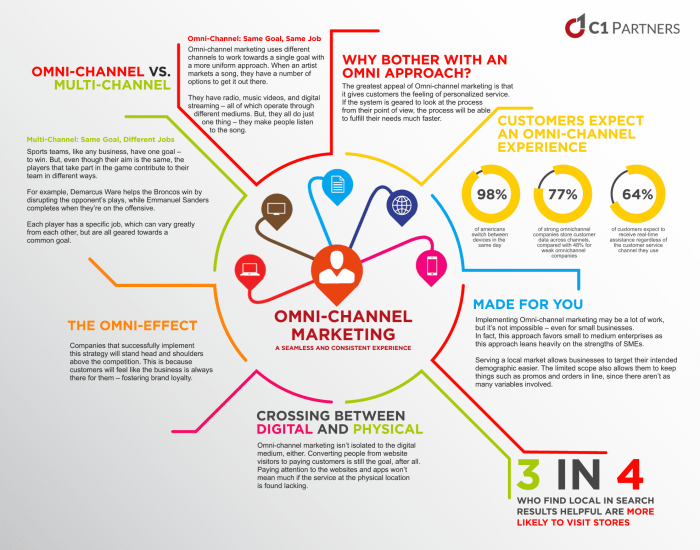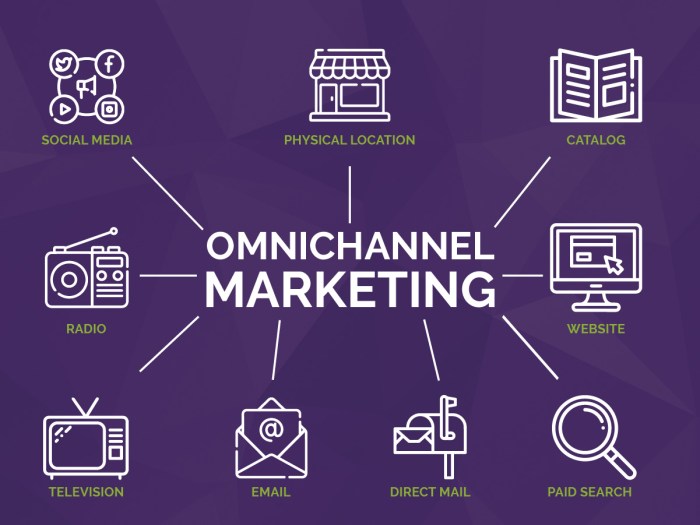Developing an Omnichannel Marketing Strategy dives deep into the world of modern marketing, exploring how businesses can create a unified customer experience across various channels. From understanding the essence of omnichannel marketing to leveraging data-driven insights, this guide is your go-to resource for revolutionizing your marketing approach.
Get ready to unlock the secrets behind successful omnichannel strategies and take your brand to new heights of customer engagement.
Understanding Omnichannel Marketing

Omnichannel marketing is a strategic approach that focuses on creating a seamless and integrated customer experience across multiple channels, both online and offline. This strategy aims to provide customers with a consistent brand message and shopping experience regardless of the channel they use.
Examples of Successful Omnichannel Marketing Strategies
- Apple: Apple seamlessly integrates its online store, physical retail locations, and mobile app to provide customers with a unified shopping experience. Customers can easily transition from browsing products online to trying them out in-store.
- Starbucks: Starbucks allows customers to order and pay for drinks through its mobile app, website, in-store, or drive-thru. This omnichannel approach enhances convenience and personalization for customers.
Key Components of an Effective Omnichannel Marketing Strategy
- Consistent Branding: Ensure that the brand message and identity are consistent across all channels.
- Seamless Integration: Integrate all channels to provide a smooth transition for customers as they move between online and offline touchpoints.
- Customer Data Utilization: Use customer data to personalize marketing messages and offers across channels.
- Analytics and Measurement: Monitor and analyze customer interactions across channels to optimize marketing strategies.
Benefits of Implementing an Omnichannel Marketing Approach for Businesses
- Improved Customer Experience: Omnichannel marketing helps businesses provide a seamless and personalized experience for customers, leading to increased satisfaction and loyalty.
- Increased Sales: By offering customers multiple touchpoints to engage with the brand, businesses can drive more sales and conversions.
- Enhanced Brand Loyalty: Consistent messaging and personalized experiences build trust and loyalty among customers, encouraging repeat purchases.
- Data-Driven Insights: Omnichannel marketing allows businesses to gather valuable customer data and insights to improve marketing strategies and product offerings.
Developing a Comprehensive Customer Persona
Creating detailed customer personas is crucial for omnichannel marketing as it helps businesses better understand their target audience, their behaviors, preferences, and pain points. By developing accurate customer personas, companies can tailor their marketing strategies to meet the specific needs of different customer segments, leading to more personalized and effective campaigns.
Importance of Customer Personas
- Customer personas provide a clear picture of the target audience, allowing businesses to create more relevant and engaging content.
- Helps in identifying the most effective channels to reach different customer segments and optimize marketing efforts.
- Enables businesses to anticipate customer needs and preferences, leading to improved customer satisfaction and loyalty.
Developing Accurate Customer Personas
- Utilize data from various sources such as website analytics, social media insights, and customer surveys to gather information about your audience.
- Segment your audience based on demographics, psychographics, and behavior patterns to create distinct customer personas.
- Validate your personas by conducting interviews, focus groups, or A/B testing to ensure they accurately represent your target audience.
Tailoring Marketing Messages
- Customer personas help in crafting personalized marketing messages that resonate with specific audience segments, increasing engagement and conversion rates.
- Allows businesses to deliver consistent messaging across different channels, providing a seamless and cohesive brand experience for customers.
- Enables targeted advertising and content creation that speaks directly to the needs and interests of each customer persona.
Examples of Successful Campaigns
One example is Nike’s customer persona “The Athlete,” which guided their omnichannel marketing strategy focusing on performance-driven products and inspirational content tailored to active individuals.
Another example is Starbucks’ customer persona “The Socializer,” influencing their campaign with a focus on community-building initiatives and social media engagement to connect with coffee enthusiasts.
Integrating Multiple Marketing Channels: Developing An Omnichannel Marketing Strategy

In today’s digital age, integrating multiple marketing channels is crucial for a successful omnichannel strategy. By utilizing various channels such as social media, email, websites, and offline avenues, brands can reach customers at different touchpoints and create a seamless customer experience.
Leveraging Social Media
- Use social media platforms like Facebook, Instagram, and Twitter to engage with customers in real-time and showcase products or services.
- Integrate social media into your overall marketing strategy by sharing consistent messaging and branding across all channels.
- Utilize social media analytics to track customer interactions and adjust your strategy accordingly.
Leveraging Email Marketing, Developing an Omnichannel Marketing Strategy
- Create personalized email campaigns that target specific customer segments based on their preferences and behaviors.
- Include links to your website or social media profiles in emails to drive traffic and encourage further engagement.
- A/B test different email formats and content to optimize performance and maximize conversions.
Leveraging Offline Channels
- Integrate offline channels such as physical stores or events with your online presence to provide a holistic brand experience.
- Use QR codes or unique promo codes in offline marketing materials to track customer interactions and measure the effectiveness of your campaigns.
- Collect customer feedback from offline interactions to improve your overall omnichannel strategy.
Consistency is key in omnichannel marketing. Ensure that your messaging and branding are consistent across all channels to build trust and recognition with your audience.
Utilizing Data and Analytics
In the world of omnichannel marketing, data and analytics play a crucial role in optimizing strategies and enhancing customer engagement. By leveraging the power of data-driven insights, businesses can personalize interactions and drive conversions effectively across various channels.
Types of Data for Analysis
- Customer demographics: Understanding the age, gender, location, and interests of your target audience can help tailor marketing messages.
- Behavioral data: Analyzing how customers interact with different channels can provide valuable insights into their preferences and behavior.
- Purchase history: Tracking past purchases and browsing behavior can help predict future buying patterns and personalize recommendations.
Examples of Data-driven Insights
-
By analyzing customer data from online and offline touchpoints, a retail store discovered that customers who engaged with their mobile app before visiting the physical store were more likely to make a purchase. As a result, they optimized their mobile app experience to drive more store visits and conversions.
-
An e-commerce company used data analytics to identify a drop-off point in their checkout process. By making adjustments based on this insight, they were able to reduce cart abandonment rates and increase overall sales.
Best Practices for Personalization and Conversions
- Segmentation: Divide your audience into smaller groups based on similar characteristics or behavior to deliver more targeted messaging.
- Automation: Use marketing automation tools to deliver personalized content at the right time and through the right channels.
- A/B testing: Experiment with different strategies and analyze the results to optimize campaigns for better engagement and conversions.